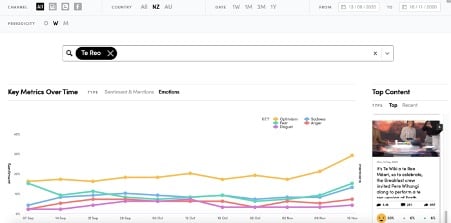.png)
First Published: 01 June, 2022
Some have taken a stance and made the decision to make change and, in some cases, other brands have supported them. Others are stepping gently into a sensitive area, while some are holding back in a wait and see mode.
I don’t believe it is so much a lack of commitment or courage as a genuine desire not to get it wrong or cause offence that holds some brands back. It is easy to make unintentional missteps. Being off code to the cultural mood can be damaging and while we are in a period of economic recovery post lockdown, companies are understandably torn between caution and embracing the infamous new normal.
Talking to New Zealanders (and we talk to thousands of them every month) it’s clear that they are thinking about it too. Looking at sentiment around te reo since Te Wiki o te Reo Māori, our social media scraping tool Radar shows high level of optimism in coverage and posts related to te reo and sentiment is also very high.

At TRA our brand equity model used to be called Brand Mana (which we are updating across our business to call Brand Edge). We chose the name because, like so many Māori words, mana captures a concept that would take a whole phrase if not a sentence or two to capture in English and it encapsulated the combined impact of brand fit, brand purpose and brand energy. We sense tested the word and we checked whether we were offending or transgressing in any way the use of the word. The people we spoke to told us that a brand could most definitely have mana and it was appropriate to attach mana to an inanimate object. But, and you knew that there was a but coming, we had failed to mention that the equity model is a way of comparing how brands perform against other brands - we were using it in a competitive context. That was where we got it wrong. Mana isn’t relative or competitive. This meant we were using it in an inappropriate way. Changing the name to Brand Edge reflects the competitive nature of the concept, i.e. having an edge on a competitor.
Many organisations in New Zealand are having similar conversations about te reo Māori, along with a wider discussion about imagery, cultural icons and diversity in their communications. Some of it prompted by Te Wiki o te Reo Māori, some by a heightened cultural awareness triggered by New Zealand’s united stand against Covid, and/or solidarity with Black Lives Matter. No matter what has triggered the conversations, it’s a good one to have and a very important one to get right.
What is clear from talking to people is that, whatever their personal views about using Māori language, they have clear expectations about how business should behave. What’s interesting is that they are also willing to cut them some slack as long as the intent is authentic, and the rationale has integrity. They don’t expect organisations to overplay their hand to the point that they lose their sense of humour. As one person put it “it’s good to see them use Te Reo though I don’t like it when they get all serious about it, Kiwis have a sense of humour and it doesn’t matter what language they’re using we can all do with cheering up.”
People also recognise that some words have become universal – kia ora, whānau, hangi, hui, kai, ngā mihi, haere mai - and these are typically seen as culturally on code ways of communicating with all New Zealanders. However, and this is the T&Cs bit, if you are going to extend your use of te reo then people expect this to come from a wider business cultural shift. What else are you doing to adopt the Māori worldview, what are you doing about staff education, do you have a recruitment strategy or collaborative partnership with Māori interest groups? How you are behaving is more important than what your stated purpose or rationale is. And if for one moment they get a sniff that your intent is driven by entirely commercial or bandwagon motives, look out because you’ll be called out. People have highly tuned antennae when it comes to organisations talking the talk but not walking the walk.
Written by Colleen Ryan, Partner, TRA
-png.png)
Category

Contact us if you have any suggestions on resources you would like to see more of, or if you have something you think would benefit our members.
Get in TouchSign up to receive updates on events, training and more from the MA.
